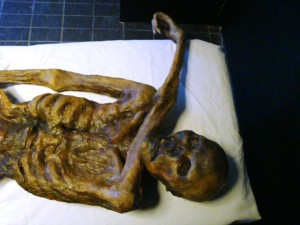TUESDAY, 3 APRIL 2012
Having been mummified in a glacier, Özti’s nuclear DNA has been completely preserved. Thanks to technological advances in whole-genome sequencing, scientists have been able to determine that he had brown eyes, blood group ‘O’, and was lactose intolerant. By comparing 2.2 million differences in short sequences of DNA, physiological details such as his predisposition to heart attack were also revealed.The study, involving the collaboration of 41 scientists, has also confirmed Özti’s ancestry - previous studies using his mitochondrial DNA had suggested that he is not related to modern humans from the Alpine region where he was found. Comparison of autosomal DNA with several Eurasian populations has shown instead that Özti is more closely related to modern inhabitants of Sardinia and Corsica. Tracing Özti’s paternity, by looking at groups of genes on his Y chromosome, suggests that his ancestors originated in the Middle East.
It’s likely that Özti’s ancestors then migrated from the Middle East, dispersing across central Europe. Populations probably settled as agricultural practice spread. This switch to an agrarian society has led to lactose tolerance in modern European populations; the absence of tolerance in Özti suggests that he was alive during a transitional period from nomadic to agricultural lifestyles.
The scientists also found Özti to be infected with Lyme disease bacterium. To date, this is the oldest documentation of the disease in humans.
Özti the Iceman has been a ‘precious’ find. Previous studies had revealed insights into the diet, clothing, and even possible tattoo culture of humans during the Copper Age in Europe. Özti’s DNA has now exposed personal characteristics, and, more importantly, dug up information about the genetic structure and migration pattern of Mediterranean communities.
Written by Adam Kenny
doi:10.1038/ncomms1701

